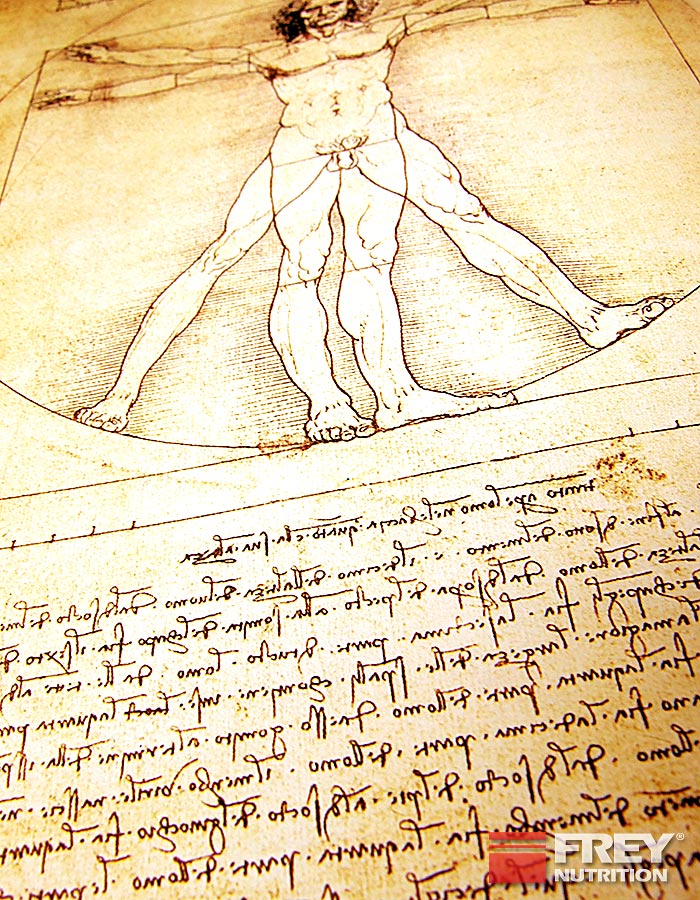CREATINE AGAINST MUSCLE LOSS
It is well known that even after a relatively short period of bed rest, both the muscle mass and muscle strength of immobilized patients decrease significantly and that reconstruction of the muscular system during convalescence can take a long time, even with regular physiotherapy and appropriate strength training.
In this context, a breakthrough was recently achieved with the use of creatine. It was shown that in volunteers who had a leg cast (immobilized) from the hip to the toes for 2 weeks, the loss of muscle mass in the immobilized leg was reduced by taking creatine compared to a control group. After the cast was removed during the rehabilitation phase, both the muscle and strength gains were significantly better in the creatine group and the diameters of all muscle fibers after rehabilitation were significantly larger than in the control group that did not take creatine. (Hespel et al. 2001) . Based on these data, creatine is already being used successfully in Swiss rehabilitation centers for the rehabilitation of patients who have undergone hip and knee joint surgery, for example.
CREATINE SUPPLEMENTATION IN PATIENTS WITH MUSCLE DISEASE
In the report "My self-experiment with creatine monohydrate" published in the German magazine "Muskelreport" 3/96 on pages 23-25, Mrs. Therese Bigge, who has suffered from limb-girdle muscular dystrophy for around 30 years, writes about her astonishingly positive experiences with supplementing her diet with creatine. She herself and, in the meantime, a whole series of other patients with various muscle diseases reported in personal letters: "The most noticeable improvements are in my ability to walk. I walk faster, more confidently, more easily, with more endurance," or: "Just one week after taking creatine, my circulatory problems and my extreme tiredness disappeared," or: "I can now walk short distances without an escort," etc.
SCIENTIFICALLY PROVEN DOUBLE-BLIND STUDIES
Such individual observations, which sound very encouraging and have been observed more and more frequently recently, must now be examined and confirmed in serious clinical-scientific double-blind studies. These individual case reports of patients suffering from muscle diseases have finally caught the attention of the medical profession.
As a result, various extensive scientific studies with such patients have finally been initiated (Tarnopolsky et al. 1997) . Prof. Tarnopolsky's group in Canada was able to show clearly positive effects on muscle strength after taking creatine in patients with various muscular and neuromuscular diseases. (Tarnopolsky and Martin 1999) . First results from such studies with muscle patients, which are now also being carried out in Germany, e.g. by Prof. Hanefeld in Göttingen (Hanefeld 1999) and Prof. Pongratz in Munich (Walter et al. 1999; Klopstock et al. 1999) are quite positive. In Switzerland, a first placebo-controlled double-blind cross-over study with Duchenne patients was carried out in December 1998 at the Inselspital in Bern. (PD. Dr. JM Burgunder, Neurological Clinic, together with Prof. T.Wallimann ETH-Zürich) started.
The work published in "Nature Medicine" by the group led by Prof. MF Beal in Boston (Klivenyi et al. 1999) , which had shown a surprisingly positive neuroprotective effect of creatine in the Huntington's disease and ALS animal model, proclaimed euphoric enthusiasm in the USA "breakthrough in the treatment of neurodegenerative diseases".
The results of the research presented at the 31st European Metabolic Group (EMG) Meeting from May 28th to 30th, 1999 in Vienna support the effectiveness of creatine in patients with various muscle diseases, as well as the neuroprotective effect of creatine. Similar positive research was also presented at the International Meeting on "From Basic Research to Clinical Application of Creatine" on June 4th, 1999 in Milan.
HOW SHOULD CREATINE BE TAKEN?
When taking creatine, the so-called "loading phase" was very popular among sportsmen and athletes. During the first week, 5 grams of creatine were taken 3-4 times a day in order to maximize the creatine and thus also the phosphocreatine content in the organs in the shortest possible time. This was followed by a "maintenance phase" with only about 3 grams of creatine per day, whereby these values apply to an adult weighing about 80 kg. For lighter people, the dose is reduced accordingly and for heavier people, it is increased accordingly.
A "CHARGING PHASE" BRINGS MORE DISADVANTAGES THAN ADVANTAGES.
However, new scientific findings have led to the general conclusion that a "loading phase" has more disadvantages than advantages, which is why it is generally avoided nowadays. The replenishment of creatine stores occurs somewhat more slowly, but after about a month, similar creatine levels are achieved in the tissues as with rapid high-dose loading, which is often associated with certain side effects, such as gastrointestinal complaints, increased muscle cramps and/or feeling of thirst, etc.
CREATINE MUST NOT BE STORED IN WATER FOR LONGER THAN 15 MINUTES, OTHERWISE IT WILL BREAK DOWN INTO WORTHLESS CREATININE.
Since creatine is relatively poorly soluble, it is important to ensure that the powder is dissolved in enough liquid or taken pure with a teaspoon with plenty of liquid. Furthermore, creatine should never be stored in water, as this quickly breaks down into creatinine, an ineffective breakdown product of creatine. Creatine should therefore always be taken immediately after mixing. When taking creatine, it is important to ensure that you drink more liquid. Since sodium chloride (NaCl) is transported into the cells along with creatine via creatine transporters, this results in increased water absorption, especially by the muscle cells, which can lead to the often observed weight gain during the first few days of taking creatine.
FURTHER BASIC RESEARCH IS NEEDED
Increased basic research and parallel clinical studies on humans are necessary to explore the diverse application possibilities of creatine supplementation. Creatine kinase is an "old" enzyme that was discovered in the 1920s (Lohmann reaction) and is often only mentioned in one sentence in biochemistry textbooks, if at all, as "an important enzyme for energy buffering and as a diagnostic serum marker after a heart attack."
Despite the fact that creatine kinase is one of the most prominent enzymes in muscle, it has only recently been possible to elucidate its molecular structure using protein crystallography and X-ray structure analysis (Fritz-Wolf et al. 1996) . Thanks to these structural data together with the new findings from the biochemistry, cell biology and molecular physiology of the enzyme mentioned here, as well as the latest results with creatine supplementation, new research groups will be looking into this interesting topic in the future. Knowledge of the exact coordinates of the individual amino acids in the structure of the creatine kinase molecule should make it possible to design specific inhibitors and/or activators of the enzyme using molecular modeling, which could then be used specifically for cancer therapy of malignant tumors that express creatine kinase. (Kornacker et al. 2001) . In addition, many of the findings presented here, verified in experimental animals, are awaiting clinical studies for the use of creatine and analogues in humans.
IT IS TO BE HOPED THAT THE VARIOUS ASPECTS OF CREATINE SUPPLEMENTATION WILL ALSO BE EXAMINED BY CLINICAL RESEARCHERS IN THE FUTURE AND, HOPEFULLY, FOLLOWED WITH GREATER ATTENTION BY PRACTICAL PHYSICIANS










